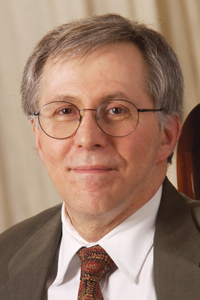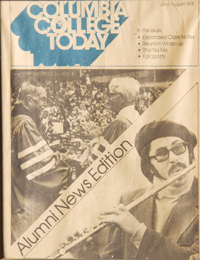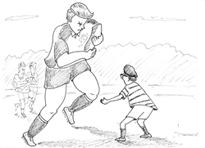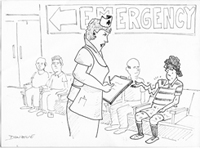|
|
 |
 |
|
FIRST PERSONMemories of UnderdevelopmentBy Jeffrey Glassman ’76, ’92 SIPA

PHOTO: STUDIO THERESA BENTZ, VIENNA 
Playing rugby was never a life’s goal. As a child, I hadn’t lain awake nights with visions of the infamous black-shirted sides from New Zealand. I didn’t go out to the backyard to pretend to be The World Famous Scrum Half. So, the thought did occur to me, as I sat in the waiting room of the Miriam Hospital in Providence, R.I., mud obliterating my Columbia blue and white rugby jersey, and the ache in my shoulder becoming ever more assertive — why, oh why, am I here? The ache in my shoulder was a result of an informal experiment by myself and a large young fellow from the Dartmouth rugby team to disprove the law of physics that states that two bodies cannot occupy the same space at the same time. The unhappy result of the experiment was a less than amicable separation of my clavicle from my scapula. Nothing, really. Five days, 200 miles, four doctors and two hospitals later, it was all over but the healing. But the question of how I found myself in such unfortunate circumstances remains. For the answer, we have to back up about six months, to fall 1972 and my arrival at Columbia. One day, soon after I arrived, I noticed a poster announcing the introductory meeting of the Columbia College Rugby Club. Suitably impressed by the potential for running and jumping, along with the sheer Ivy League-ness of it, I decided to check it out. Somebody explained the rules of rugby. When the dust settled, the blackboard looked like it escaped from a seminar on the Heisenberg uncertainty principle. Nevertheless, I strolled back to Carman Hall, clutching my pamphlet, This Is Rugby, not knowing my scrum half from my back outside, but convinced that rugby was for me. Rugby is a game of barely controlled violence played by two teams of 15. There are no timeouts, substitutions or protective padding or equipment of any kind. The object of the game is to touch down the rugby ball in your opponent’s endzone, and keep the other guy from doing the same. A word about rugby players: They tend to be large people. In America, they are often converts from football. And they are often insane. I played rugby. I am 5-7 and then weighed about 140 pounds. I never played organized football. So I guess I made up in insanity what I lacked in the other prerequisites. A few days after our orientation meeting, high with anticipation at my entry into the clubby, oak-lined, beer-soaked world of Ivy League rugby, I attended my first practice session. The vision was of a stained sepia photograph of earnest young men, proudly exhibiting a gleaming silver loving cup, their stoic expressions half-hidden by gigantic handlebar moustaches. An idyllic scene. But the urban realities of New York in the ’70s mercilessly intruded. Our field was located at the lowest level of Riverside Park at 108th Street, cheek-by-jowl with the West Side Highway. Riverside Park can be lovely. But with traffic hurtling by, spreading unknown toxins over a dusty strip of brown called a field, with the New Jersey “skyline” enveloped in a gray miasma, the park is just not reminiscent of New Haven on a crisp October afternoon in 1906. Eventually, I picked up the basics of the game, and the chaos diminished somewhat. I was relegated to the wing, the position farthest out from the center of the field, where speed was more important for survival than girth. The basic rugby formation consists of seven backs lined up diagonally across the field in a line emanating from the scrum. The other eight intertwine over the ball along with eight from the opposing team. This is the scrum, rugby’s perverse way of getting the ball into play. 

Jeffrey Glassman ’76 on the cover of the July/August 1978 issue of CCT. 
When it all works right, your forwards are supposed to push the opposing forwards over the ball, the scrum half, who is kind of a quarterback, picks it up and whips a pass, underhanded and backward, to his first back, who runs until he’s about to be tackled, and then at the last split-second, tosses to the next back behind him, and so on down the line until it reaches the speedy wing (me) who scampers for the touchdown. Don’t believe it. It doesn’t work. Or at least it didn’t for the Columbia College Rugby Club, 1972–73. It’s not that we had a bad season. We beat Downstate Medical School, and just because the school isn’t known as a rugby power doesn’t mean they weren’t tough! But then we’d have to play a side like Dartmouth. It was a cold, gray, November morning in Hanover, N.H. The sky seemed only inches above our heads, and the temperature was in the 20s. I have many memories of that game, including the score: 50–0. Them. That was thankfully our last match of the fall, and by the spring we had all healed enough to give it another try. The crowning event of every rugby season was the Ivy League tournament held at Brown. I expected to be a happy spectator. We gathered at 3 a.m. in the Furnald lobby, but not everyone expected showed up. We had 16, one over the number necessary to field a team. I was the 16th. But on the way to Providence, one of our three cars had engine trouble. The driver had to stay with the car, and as in the plot of many Broadway musicals, the stand-in was about to get his big chance. We arrived at Brown minutes before the opening whistle against, who else, Dartmouth. We kicked off to open the game with me on the wing. For the first six or seven minutes, we played them pretty evenly, and Dartmouth hadn’t scored. We were feeling pretty good, considering this was the team that had demolished us in the fall. Then Dartmouth won a scrum and executed a perfect play. The scrum half flipped the ball out to his backs. Each back in turn flipped to the next back just as he was about to be tackled. Suddenly, their wing had the ball, and only I stood between him and our endzone. I think this is a good point to freeze the action and step back and analyze exactly what is going on. That’s me. The little guy with the glasses and the headband. Now, you see that other guy, the big guy with the blond hair and the ball. He wants to get over there. You can see that they are both looking very determined. You can see the two figures approach each other, closer ... closer. OK, you can open your eyes now. You see that little blue and green heap. Yeah, that’s them. Wait, I see movement. The guy in the blue is crawling around. It looks as if he’s looking for something. Someone is handing him something. Oh, his glasses. The guy in the green is still down. Thank you, now back to our studios in New York. As soon as I got up, I knew that all was not as it should be. And the source of the problem was definitely my right shoulder. I swiveled my head ever so gingerly and was relieved to see nothing was protruding from my body that should not have been. But my shoulder didn’t feel right at all. One of the bones seemed to be in a place where I didn’t remember its ever being before. I told the captain that I should probably sit down. “C’mon, how bad can it be? I don’t see any blood. Can’t you just play for a little while longer?” “It’s bad.” “We need you.” “It’s bad.” I walked slowly toward the sideline as the game continued. I was determined not to throw up, and not to cry. I heard an internal voice. “Look at you. You wake up at three o’clock in the morning, drive 200 miles, play seven minutes and end up in the hospital. What a schlimazl.” “But I stopped a touchdown,” I replied. The voice just laughed. I was definitely the odd one out in the emergency room. Not one other person there was wearing shorts and a blue and white jersey caked with mud. And my right arm hung at a disturbing angle. So, this is an emergency room, I thought. I had heard about emergency rooms but I never had the pleasure. Interminable waits. Frigid personnel. Inept doctors. Always one to give the benefit of the doubt, I attributed these horror stories to imaginative sitcom writers and bored yentas. Little did I know. 


illustrations by John donohue  I sat and waited. And waited and sat. My arm and shoulder began to throb, and I had already read the June 1970 issue of Humpty-Dumpty cover to cover three times when I was called. Awaiting me was not a person of mercy and healing, but the triage nurse. A plump middle-aged woman with a pleasant face, at home she was probably a devoted wife and loving mother, but put her in a white uniform, and she becomes Vlad the Impaler. Her goal? To wring every last bit of information, relevant or otherwise, before she deigns to send the misbegotten wretch off to be made well again. On we went. “Address?” … and on. “Father’s occupation?” and on … and on … and on. “Social Security number?” And on. “How did the injury occur?” “I was, uh, playing rugby,” I answered, striving for outward calm while the pain in my shoulder and my worry of ever seeing a doctor increased. “Rugby, huh?” she said in that cheerful, mindless voice, “Is that with one ‘g’ or two?” With that, my reserves of patience and poise were dry. “Lady, my arm is falling off and you’re asking me for a spelling lesson? One ‘g,’ ” I yelled. “Now can I see a doctor?” The first thing the doctor said when I told him was, “Aren’t you a little small to be playing rugby?” “Well,” I said, “it’s a long story.” Jeffrey Glassman ’76, ’92 SIPA is a Foreign Service officer at the U.S. Mission to the Organization for Security and Cooperation in Europe in Vienna, Austria. He can be reached at glassmanj@state.gov.
|
|
||||||||||||||||||||||||||||